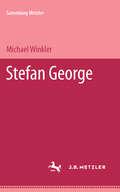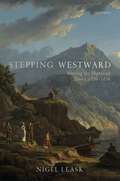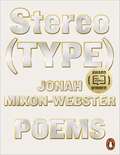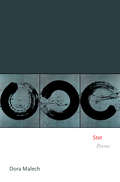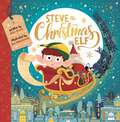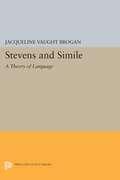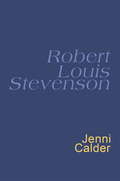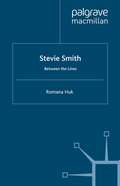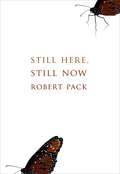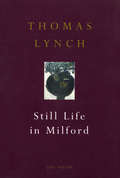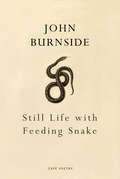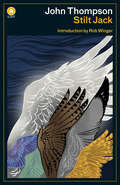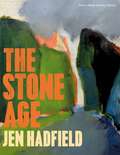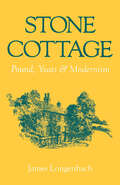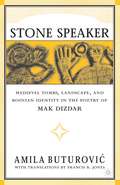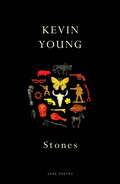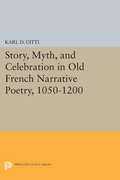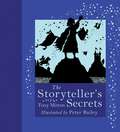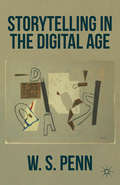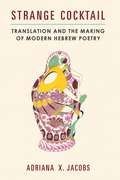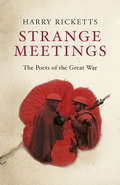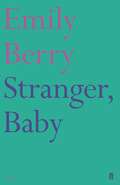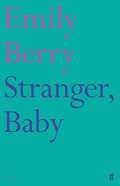- Table View
- List View
Stepping Westward: Writing the Highland Tour c. 1720-1830
by Nigel LeaskStepping Westward is the first book dedicated to the literature of the Scottish Highland tour of 1720-1830, a major cultural phenomenon that attracted writers and artists like Pennant, Johnson and Boswell, William and Dorothy Wordsworth, Coleridge, Scott, Hogg, Keats, Daniell, and Turner, as well as numerous less celebrated travellers and tourists. Addressing more than a century's worth of literary and visual representations of the Highlands, the book casts new light on how the tour developed a modern literature of place, acting as a catalyst for thinking about improvement, landscape, and the shaping of British, Scottish, and Gaelic identities. It pays attention to the relationship between travellers and the native Gaels, whose world was plunged into crisis by rapid and forced social change. At the book's core lie the best-selling tours of Pennant and Dr Johnson, associated with attempts to 'improve' the intractable Gaidhealtachd in the wake of Culloden. Alongside the Ossian craze and Gilpin's picturesque, their books stimulated a wave of 'home tours' from the 1770s through the romantic period, including writing by women like Sarah Murray and Dorothy Wordsworth. The incidence of published Highland Tours (many lavishly illustrated), peaked around 1800, but as the genre reached exhaustion, the 'romantic Highlands' were reinvented in Scott's poems and novels, coinciding with steam boats and mass tourism, but also rack-renting, sheep clearance, and emigration.
Stepping Westward: Writing the Highland Tour c. 1720-1830
by Nigel LeaskStepping Westward is the first book dedicated to the literature of the Scottish Highland tour of 1720-1830, a major cultural phenomenon that attracted writers and artists like Pennant, Johnson and Boswell, William and Dorothy Wordsworth, Coleridge, Scott, Hogg, Keats, Daniell, and Turner, as well as numerous less celebrated travellers and tourists. Addressing more than a century's worth of literary and visual representations of the Highlands, the book casts new light on how the tour developed a modern literature of place, acting as a catalyst for thinking about improvement, landscape, and the shaping of British, Scottish, and Gaelic identities. It pays attention to the relationship between travellers and the native Gaels, whose world was plunged into crisis by rapid and forced social change. At the book's core lie the best-selling tours of Pennant and Dr Johnson, associated with attempts to 'improve' the intractable Gaidhealtachd in the wake of Culloden. Alongside the Ossian craze and Gilpin's picturesque, their books stimulated a wave of 'home tours' from the 1770s through the romantic period, including writing by women like Sarah Murray and Dorothy Wordsworth. The incidence of published Highland Tours (many lavishly illustrated), peaked around 1800, but as the genre reached exhaustion, the 'romantic Highlands' were reinvented in Scott's poems and novels, coinciding with steam boats and mass tourism, but also rack-renting, sheep clearance, and emigration.
Stereo(TYPE)
by Jonah Mixon-WebsterThe award-winning poet's darkly riotous debut, exploring stereotypes of Black male identity and sexuality in a corrupt systemLyrical, loud and radically urgent, Jonah Mixon-Webster's debut aims its sights at the words and images that shape us and the corrupt forces that stand in the way of our freedom. Stereo(TYPE) is a reckoning and a force. It is a revision of our most sacred mythologies - and a work of documentary poetry reporting from Mixon-Webster's hometown of Flint, Michigan, where untainted tap water is still not guaranteed and the legacies of racist policies persist. Challenging stereotypes through scenes scattered with satire, violence, and the extreme vagaries of everyday life, Mixon-Webster explores the places where space and body, race and region and sexuality and class meet and intersect. He invents visual/sonic forms, recasts poems as FAQs and transcripts, and dives into dreamscapes and modern tragedies. Interrogating language and the ways we wield it as both sword and shield, Stereo(TYPE) is a rapturous collection of vital and beautiful poems.
Stet: Poems (Princeton Series of Contemporary Poets #139)
by Dora MalechA fascinating collection of serious and playful poems that tap the inventive possibilities of the anagram and other constraining formsIn Stet, poet Dora Malech takes constraint as her catalyst and subject, exploring what it means to make or break a vow, to create art out of a life in flux, to reckon with the body’s bounds, and to arrive at a place where one might bear and care for another life. Tapping the inventive possibilities of constrained forms, particularly the revealing limitations of the anagram, Stet is a work of serious play that brings home the connections and intimacies of language.“Stet,” from the Latin for “let it stand,” is a proofreading term meaning to retain or return to a previous phrasing. The uncertainty of changes made and then reconsidered haunts Stet as its poems explore what is left unsaid through erasures, redaction, and the limitations of spelling. How does one “go back” on one’s word or “stand by” one’s decisions? Can a life be remade or revised, or is the past forever present as in a palimpsest? Embodying the physicality and reproductive potentiality inherent in the collection’s forms and figures, Stet ends expectantly, not searching for closure but awaiting the messy, living possibilities of what comes next.By turns troubling and consoling, Stet powerfully combines lyric invention and brilliant wordplay.
Steve the Christmas Elf
by Billy Dunne Ben WhitehouseA humorous and heart-warming story about a little elf called Steve and a little girl called May, who help each other find their way. Steve the Christmas elf is in the North Pole, busy making toys for the big day. But he suddenly wonders: what if the children he’s making toys for don’t exist? It’s not like he’s ever seen them ...Join Steve on a Christmas Eve adventure as he sneaks on board Santa’s sleigh, befriends a little girl who’s found herself on the naughty list and gets himself into a whole load of festive trouble.
Stevens and Simile: A Theory of Language
by Jacqueline Vaught BroganBrogan traces in detail the Wallace Stevens increasingly sophisticated use of similes in order to demonstrate how they satisfied both his own intellectual needs and the needs of modern poetry. While thoroughly grounded in the poetry of Stevens, her book also explores the nature of language itself by demonstrating the possibilities, as well as the limitations, of either a romantic or a deconstructive conception of language.Originally published in 1986.The Princeton Legacy Library uses the latest print-on-demand technology to again make available previously out-of-print books from the distinguished backlist of Princeton University Press. These editions preserve the original texts of these important books while presenting them in durable paperback and hardcover editions. The goal of the Princeton Legacy Library is to vastly increase access to the rich scholarly heritage found in the thousands of books published by Princeton University Press since its founding in 1905.
Stevenson: Everyman's Poetry
by Robert Louis Stevenson Jenni CalderPoems for children, ballards for his friends in the South Seas, poetic tales of Scotland - a selection of the poetry Stevenson wrote all his life.
Stevie Smith: Between the Lines
by R. HukIn this first book-length study of Stevie Smith, Romana Huk reassesses the work of this major twentieth-century woman writer as emerging not only from the practices of female literary modernism, but also from within the tumultuous cultural context of mid-century Europe. Huk considers both the poems and the novels in the light of their cultural and literary context. Amongst the work treated here is Smith's rarely discussed trilogy of novels: Novel on Yellow Paper , Over the Frontier and The Holiday .
Still Here, Still Now
by Robert PackRobert Pack is one of America’s most eminent nature poets, and his virtuoso talents are on glorious display in Still Here, Still Now, his nineteenth volume of verse. With styles ranging from lyric to narrative, and themes stretching from biblical concerns to meditations on contemporary science, Pack’s poetry is composed in strongly rhythmic cadences and a diction that is direct and accessible. In four different sections of thematically and stylistically divergent verse, Still Here, Still Now delivers many of the elements of Pack’s poetry readers have come to admire and expect—both the humorous and the elegiac. The first section of the book contains traditional lyrics that celebrate family ties and seek consolations for the passing of personal and evolutionary time. The poems in this group address a named or unnamed auditor in a voice of intimate engagement. Featuring the most narrative selections in the book, the second section consists of fable-like stories, rich with innuendo and implication. The characters in these poems make choices that press against the events and circumstances that challenge and define them. Embodying what Harold Bloom has called Pack’s “courage to surmount suffering,” the poems of the third section are largely devoted to biblical themes and philosophical speculations on the meaning of happiness and the uses of suffering. Here, Pack’s empathy for the human condition as well as his forebodings about the prospect of human survival are on poignant display. The final section of the book turns to Pack's abiding interest in landscape and the ways in which the place one inhabits contains and animates our individual lives. Ripe with many years, Pack remains a vital presence in American letters. Still Here, Still Now is an affecting and graceful addition to the oeuvre of a poet whose compelling and distinct voice will continue to resonate among his loyal readers.
Still Here, Still Now
by Robert PackRobert Pack is one of America’s most eminent nature poets, and his virtuoso talents are on glorious display in Still Here, Still Now, his nineteenth volume of verse. With styles ranging from lyric to narrative, and themes stretching from biblical concerns to meditations on contemporary science, Pack’s poetry is composed in strongly rhythmic cadences and a diction that is direct and accessible. In four different sections of thematically and stylistically divergent verse, Still Here, Still Now delivers many of the elements of Pack’s poetry readers have come to admire and expect—both the humorous and the elegiac. The first section of the book contains traditional lyrics that celebrate family ties and seek consolations for the passing of personal and evolutionary time. The poems in this group address a named or unnamed auditor in a voice of intimate engagement. Featuring the most narrative selections in the book, the second section consists of fable-like stories, rich with innuendo and implication. The characters in these poems make choices that press against the events and circumstances that challenge and define them. Embodying what Harold Bloom has called Pack’s “courage to surmount suffering,” the poems of the third section are largely devoted to biblical themes and philosophical speculations on the meaning of happiness and the uses of suffering. Here, Pack’s empathy for the human condition as well as his forebodings about the prospect of human survival are on poignant display. The final section of the book turns to Pack's abiding interest in landscape and the ways in which the place one inhabits contains and animates our individual lives. Ripe with many years, Pack remains a vital presence in American letters. Still Here, Still Now is an affecting and graceful addition to the oeuvre of a poet whose compelling and distinct voice will continue to resonate among his loyal readers.
Still Life In Milford: Poems (Cape Poetry Ser.)
by Thomas LynchIn Still Life in Milford, Lynch casts the cold eye we are told to on life and death, history and memory, the local and the larger geographics. Examining the dynamics of faith, remembrance, and intimate conduct, these poems are informed by end times, tribulations and visions that make up the ordinary enterprise of daily life. Colloquy and narrative, soliloquy and tribute, Still Life in Milford engages the full register of the poet's voices as elegist, eulogist, obituarist, straight man and passer-by to achieve a difficult and inimitable harmony.
Still Life with Feeding Snake
by John BurnsideFrom our earliest childhood experiences, we learn to see the world as contested space: a battleground between received ideas, entrenched conventions and myriad Authorised Versions on the one hand, and new discoveries, terrible dangers, and everyday miracles on the other. As we grow, that world expands further, to include new species, lost continents, the realm of the dead and the lives of others: cosmonauts swim in distant space, unseen creatures pass through a garden at dusk; we are surrounded by delectable mysteries.The question of this contested, liminal world sits at the centre of Still Life with Feeding Snake, whose poems live at the edge of loss, or on the cusp of epiphany, always seeking that brief instant of grace when we see what is before us, and not just what we expected to find. In ‘Approaching Sixty’, the poet watches as a woman unclasps her hair: ‘so the nape of her neck/is visible, slender and pale/for moments, before the spill/of light and russet/falls down to her waist’. This, like each poem in the book, becomes an essay in still life and a memento mori, illuminating transient experience with a profound clarity and a charged, sensual beauty.
Stilt Jack (A List)
by John ThompsonThe much-loved, yet undervalued, final book of poems by British-Canadian poet John Thompson, is reissued in a handsome edition, featuring a new introduction by Rob Winger.Originally published in 1978, Stilt Jack is a series of powerful soliloquies on the complexity of love and the process of living. These are made immediate through Thompson’s command of metaphor, his eye for the New Brunswick landscape, his intense, often elliptical way of transfiguring everyday things into shorthand symbols of reality. This remarkable sequence of poems is based on the ghazal, an ancient Persian poetic form which is discussed in Thompson’s introduction to the original edition of the book.These poems more than fulfill the promise of Thompson’s first collection, At the Edge of the Chopping There Are No Secrets. Stilt Jack is the last testament of a major poet at the pinnacle of his craft.
The Stone Age
by Jen HadfieldAt first sight, Jen Hadfield’s new collection is an astonishingly sharp depiction of the wild landscape of her Shetland home, its people and their working lives, and the things they make and live amongst. But the reader will soon discover in The Stone Age a work of visionary power: in Hadfield’s telling, everything – door and wall, flower and rain, shore and sea, the standing stones whose presences charge the land – has a living consciousness, one which can be engaged with as a personal encounter. The Stone Age is a timely reminder that our neurodiversity is a gift: we do not all see the world the world in the same way, and the sharing of our various experience enriches it immeasurably. Hadfield’s lyric line and unashamedly high-stakes wordplay are speech hard-won from silence, and provide nothing less than a portal into a different kind of being. The Stone Age is the work of a singular artist at the height of her powers, one which dramatically extends the range of our shared experience.
Stone Cottage: Pound, Yeats, and Modernism
by James LongenbachAlthough readers of modern literature have always known about the collaboration of W.B. Yeats and Ezra Pound, the crucial winters these poets spent living together in Stone Cottage in Sussex (1913-1916) have remained a mystery. Working from a large base of previously unpublished material, James Longenbach presents for the first time the untold story of these three winters. Inside the secret world of Stone Cottage, Pound's Imagist poems were inextricably linked to Yeats's studies in spiritualism and magic, and early drafts of The Cantos reveal that the poem began in response to the same esoteric texts that shaped Yeats's visionary system. At the same time, Yeats's autobiographies and Noh-style plays took shape with Pound's assistance. Having retreated to Sussex to escape the flurry of wartime London, both poets tracked the progress of the Great War and in response wrote poems--some unpublished until now--that directly address the poet's political function. More than the story of a literary friendship, Stone Cottage explores the Pound-Yeats connection within the larger context of modern literature and culture, illuminating work that ranks with the greatest achievements of modernism.
Stone Speaker: Medieval Tombs, Landscape, and Bosnian Identity in the Poetry of Mak Dizdar
by A. ButurovicThe Poet Mak Dizdar (d.1971) has become a cultural icon in contemporary Bosnia-Herzegovina. Inspired by the lapidary imagery and epitaphs of medieval Bosnian tombstones, his best-acclaimed collection of poetry, Stone Sleeper , reawakens the medieval voices and assigns them a new role in the historical imagination of contemporary Bosnians. In this study, Amila Buturovic looks at Stone Sleeper's recovery of the ancestral world as an effort to refashion the sentiments of collective belonging. In treating the medieval tombstones as sites of collective memory, Dizdar's poetry evokes new possibilities for Bosnians to cast aside national differences based primarily on religion and embrace a pluralistic identity rooted in the sacred landscape of medieval Bosnia.
Stones
by Kevin Young**SHORTLISTED FOR THE T.S. ELIOT PRIZE 2021**A book of loss, looking back, and what binds us to life, by a towering poetic talent, 'one of the poetry stars of his generation' (Los Angeles Times).'We sleep long, / if not sound,' Kevin Young writes early on in this exquisite gathering of poems, 'Till the end / we sing / into the wind.' In scenes and settings that circle family and the generations in the American South - one poem, 'Kith', exploring that strange bedfellow of 'kin' - the speaker and his young son wander among the stones of their ancestors. 'Like heat he seeks them, / my son, thirsting / to learn those / he don't know / are his dead.' Whether it's the fireflies of a Louisiana summer caught in a mason jar (doomed by their collection), or his grandmother, Mama Annie, who latches the screen door when someone steps out for just a moment, all that makes up our flickering, precarious joy, all that we want to protect, is lifted into the light in this moving book. Stones becomes an ode to Young's home places and his dear departed, and to what of them - of us - poetry can save.
Story, Myth, and Celebration in Old French Narrative Poetry, 1050-1200
by Karl D. UittiTwelfth-century France has been described as the key to many of the most important developments of medieval civilization. Nowhere is this description more accurate than in the domain of poetic invention. The years 1050 to 1200 witnessed the development of a brilliant body of vernacular narrative that not only expressed the complexity of its own time but also bequeathed to posterity a wide gamut of creative possibilities.Although much has been written about the works of this period, Karl Uitti offers the first critically orientated overview of this poetry as poetry. In the sections devoted to the Songs of Alexis and Roland he studies the narrative as it serves, in various ways, truths exterior to its own organization. These include the implications of Alexis' imitation of Christ and the way the Song of Roland is history conceived in literary and poetic terms. Although a number of devices are examined, the poems are seen in terms of their total significance.The second part of the book, dedicate principally to the œuvre of Chrétien de Troyes, discusses a new kind of poetry, poetry whose truth depends on the reader's submitting entirely to the internal coherence of each work—in a very meaningful sense the poem itself is the thing. What it says is specifically a matter of how it says it. No higher claim for the dignity of poetic activity has ever been made.Originally published in 1973.The Princeton Legacy Library uses the latest print-on-demand technology to again make available previously out-of-print books from the distinguished backlist of Princeton University Press. These editions preserve the original texts of these important books while presenting them in durable paperback and hardcover editions. The goal of the Princeton Legacy Library is to vastly increase access to the rich scholarly heritage found in the thousands of books published by Princeton University Press since its founding in 1905.
The Storyteller's Secrets
by Tony Mitton Peter BaileyWhen twins Toby and Tess meet a mysterious old traveller, they're fascinated by his magical tales of far-off places, strange enchantments and unbelievable miracles. Each time he visits the village he brings them a new tale and a special story-reminder from the bundle that he carries on his back.Most intriguing of all is the Map of Marvels, which shimmers and shifts and invites the children to make incredible journeys of their own.
Storytelling in the Digital Age
by W. PennThrough a professional story-teller's sometimes humorous commentary on culture and literature from The Odyssey on , the book suggests that literature is not an artifact to be studied but a living process. Often irreverent, crossing literary and scholarly lines, Penn aims to discover what literature does for an imaginatively engaged reader.
Strange Cocktail: Translation and the Making of Modern Hebrew Poetry (Michigan Studies In Comparative Jewish Cultures)
by Adriana X. JacobsFor centuries, poets have turned to translation for creative inspiration. Through and in translation, poets have introduced new poetic styles, languages, and forms into their own writing, sometimes changing the course of literary history in the process. Strange Cocktail is the first comprehensive study of this phenomenon in modern Hebrew literature of the late nineteenth century to the present day. Its chapters on Esther Raab, Leah Goldberg, Avot Yeshurun, and Harold Schimmel offer close readings that examine the distinct poetics of translation that emerge from reciprocal practices of writing and translating. Working in a minor literary vernacular, the translation strategies that these poets employed allowed them to create and participate in transnational and multilingual poetic networks. Strange Cocktail thereby advances a comparative and multilingual reframing of modern Hebrew literature that considers how canons change and are undone when translation occupies a central position—how lines of influence and affiliation are redrawn and literary historiographies are revised when the work of translation occupies the same status as an original text, when translating and writing go hand in hand.
Strange Meetings: The Poets of the Great War
by Harry RickettsStrange Meetings provides a highly original account of the War Poets of 1914-1918, written through a series of actual encounters, or near-encounters, from Siegfried Sassoon's first, blushing meeting with Rupert Brooke over kidneys and bacon at Eddie Marsh's breakfasts before the war, through famous moments like Sassoon's encouragement of Owen when both are in hospital at the same time; on to the poignant meeting between Edward Thomas's widow and Ivor Gurney in 1932; and the last, strange lunch and 'longish talk' of Sassoon and David Jones in 1964, half a century after the great war began. Among the other poets and writers we encounter are Vera Brittain, Roland Leighton, Robert Graves, Isaac Rosenberg, Robert Nichols and Edmund Blunden. Ricketts's unusual approach allows him to follow their relationships, marking their responses to each other's work and showing how these affected their own poetry - one potent strand, for example, is the profound influence of Brooke, both as a model to follow and a burden to reject. The stories become intensely personal and vivid - we come to know each of the poets, their family and intellectual backgrounds and their very different personalities. And while the accounts of individual lives achieve the imaginative vividness of a novel, they also give us an entirely fresh sense of Georgian poetry, conveying all the excitement and frustration of poetic creation, and demonstrating how the whole notion of what poetry should be 'about' became fractured and changed for ever by the terrible experiences of the war.
Stranger, Baby
by Emily BerryEmily Berry's Dear Boy was described as a 'blazing debut', winning the Forward Prize for Best First Collection in 2013. Stranger, Baby, its follow-up, is marked by the same sense of fantasy and play, estrangement and edgy humour for which she has become known. But these poems delve deeper again, in their off-kilter and often painful encounter with childhood loss. This is a book of mourning, recrimination, exhilaration and 'oceanic feeling': 'A meditation on a want that can never be answered.'
Stranger, Baby
by Emily BerryEmily Berry's Dear Boy was described as a 'blazing debut', winning the Forward Prize for Best First Collection in 2013. Stranger, Baby, its follow-up, is marked by the same sense of fantasy and play, estrangement and edgy humour for which she has become known. But these poems delve deeper again, in their off-kilter and often painful encounter with childhood loss. This is a book of mourning, recrimination, exhilaration and 'oceanic feeling': 'A meditation on a want that can never be answered.'
